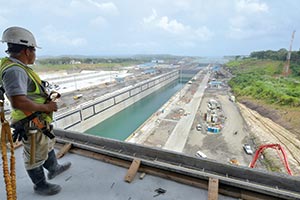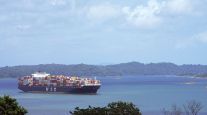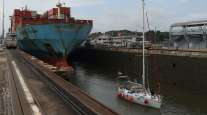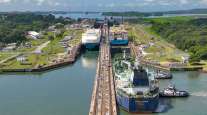Expansion of Panama Canal Nearly Finished, but Extent of US Freight Shift Still Debated

Nearly a decade in the making, the expansion of the Panama Canal is expected to be ready for commercial traffic in late spring.
However, a vigorous debate continues over just how much that project will shift U.S.-bound ocean freight to the East Coast at a time when new, larger ships that are too big to traverse even the widened canal already are servicing West Coast ports.
Today, the century-old canal linking the Pacific Ocean and the Caribbean Sea can accommodate only ships carrying up to about 5,000 20-foot containers, but growth in the size of cargo vessels helped prompt the Panama Canal Authority to begin the $5.25 billion expansion in 2007.
Soon, larger containerships — known as New Panamax or Neo Panamax vessels — that can carry as many as 14,000 industry-standard 20-foot-equivalent units will be able to use the canal. That could alter the balance of ocean shipping between the East and West coasts as well as the trucking industry that serves the ports.
“The canal expansion is going to distribute the flow of goods more evenly between the coasts,” predicted Brad Jacobs, CEO of XPO Logistics, which acquired less-than-truckload carrier Con-way Inc. and intermodal firms Pacer International and Bridge Terminal Transport within the past two years.
East Coast ports including New York-New Jersey, Baltimore, Miami and Virginia have joined, or are on the verge of joining, many West Coast ports in dredging to a channel depth of at least 50 feet to be able to service those bigger ships. Charleston, South Carolina, which is at 45 feet, aims to deepen its harbor to 52 feet by 2019. Savannah, Georgia, which receives 37% of the Asian container traffic that comes to the East Coast via the canal, is at 42 feet and set to reach 47 feet in 2020, although its high water mark is 7 feet deeper.
Like Jacobs, Charlie McGee, vice president of international solutions at Averitt Express, foresees a 10% shift in container traffic from the West to the East.
“The West Coast carriers and the railroads aren’t going to sit still and watch their market share diminish,” McGee said. “They’re going to adjust their pricing where they need to. With the size of the Northeast’s population, until New York can be part of a string of ports that can accommodate the largest vessels that can go through the canal, I don’t think there will be a big switch to the East Coast.”
A construction project to raise the roadway of the Bayonne Bridge, which connects New Jersey and Staten Island, New York, to allow larger cargo vessels to pass underneath won’t be complete until late 2017, but Steve Coleman, a spokesman for the Port Authority of New York and New Jersey, said that delay won’t have a major effect on the facility.
However, Jeff Bader, president of the Association of Bi-State Motor Carriers, whose members handle nearly three-quarters of the port’s truck volume, questioned whether the port will be able to handle the increased volume of freight that the bigger ships will bring.
Meanwhile, infrastructure improvements at the East Coast’s southernmost post are complete.
“We’re entering a new big ship era, and PortMiami is ready,” port spokeswoman Andria Muniz-Amador said. She noted the facility’s recently finished $1 billion capital infrastructure project that included dredging to 50-52 feet, moving to full on-dock rail and a tunnel that greatly improves access to nearby major highways. “We now can link to 70% of the U.S. population in four days or less via on-dock rail. The Panama Canal expansion is going to be great for Miami.”
And yet, the expanded canal might be somewhat outmoded before it even opens. An 18,000-TEU ship — too large to transit the canal’s new lane and locks — visited the ports of Los Angeles and Oakland, California, during the final week of 2015.
“This is a harbinger,” said Mike Zampa, director of communications for the Port of Oakland. “Once the dam is broken, the flood comes. There will be more ships of this size to follow.”
As of June 1, 2015, only 3% of the containerships in use across the globe were 18,000 TEUs or larger, but 31% of the ships on order were at least that size, and 21% of orders were for ships between 13,300 and 17,999 TEUs, according to a December report by consultant ICF International, which cited data from research firm Alphaliner.
“In the long term, I think Panama made a mistake by not allowing for the megaships,” Averitt’s McGee said.
West Coast ports also pointed to the growing size of containerships.
“With bigger ships coming every day, it’s less and less likely that [the expanded canal] is going to have that big an impact on us,” Port of Long Beach, California, spokesman Art Wong said.
That’s a big change from the feeling out West not long ago.
“There was a great deal of hysteria when people began to realize this project was for real,” said Jock O’Connell, a California-based economist who specializes in the logistics of trade. “There were estimates that 25% of the cargo inbound to the ports of L.A. and Long Beach [representing the vast majority of their imports bound for east of the Mississippi River] would be lost to the canal and hence to Gulf and East Coast ports. That’s been pooh-poohed for the most part.”
Neil Boothby, transportation manager for freight-forwarding firm Damco Distribution Services Inc., said the larger vessels traveling through the expanded canal will bring both benefits and challenges for East Coast port operations.
“The benefits will be potentially extra volume and new customers,” he said. “But can the port infrastructure handle the extra volume? The next few years will be a challenge.”
John Martin, a consultant with nearly 40 years of experience in maritime issues, said he believes that any East Coast port as deep as 47 feet will benefit.
O’Connell, however, strongly disagreed.
“In three, four or five years, several port authorities will have a lot of explaining to do about why they spent all this money on expansion and the ships never showed up,” he said.
As shipping lines move toward larger containerships to gain economies of scale, the number of viable ports of call likely will decline, said Tara Mattina, a spokeswoman for the Northwest Seaport Alliance — a partnership formed in August by the ports of Seattle and Tacoma, Washington.
“There will be winners and losers,” she said. “But if you don’t invest, you don’t have a chance to become one of the winners.”
O’Connell said he believes that Savannah and Charleston will gain from their proximity to the growing number of automobile plants in the South, while cargo that is perishable or likely to go out of fashion quickly still will need to reach shelves as fast as possible, so West Coast ports will continue to handle those goods. O’Connell added that the value of imports at West Coast ports is more than a third higher than at those on the East Coast.
While the boom in on-dock rail figures will have a negative effect for long-distance trucking, cargo headed for destinations within 500 miles of a port likely will still move by truck.
“The cargo will ultimately be on a truck at some point, either for its entire route or for its last mile,” American Association of Port Authorities President Kurt Nagle said. “The cargo volumes are going to be going up to such a degree that while there may be some modest shifts, every mode will see significant growth.”
Despite the new, massive ships that will be too big for the expanded canal, Nagle remains upbeat about its effect on American ports and their customers — something he expects the industry will begin to understand better in 2017.
“Every port is watching the Panama Canal to see what happens,” said Zampa, of the Port of Oakland. “We’ll see if the reality lives up to the promise.”




